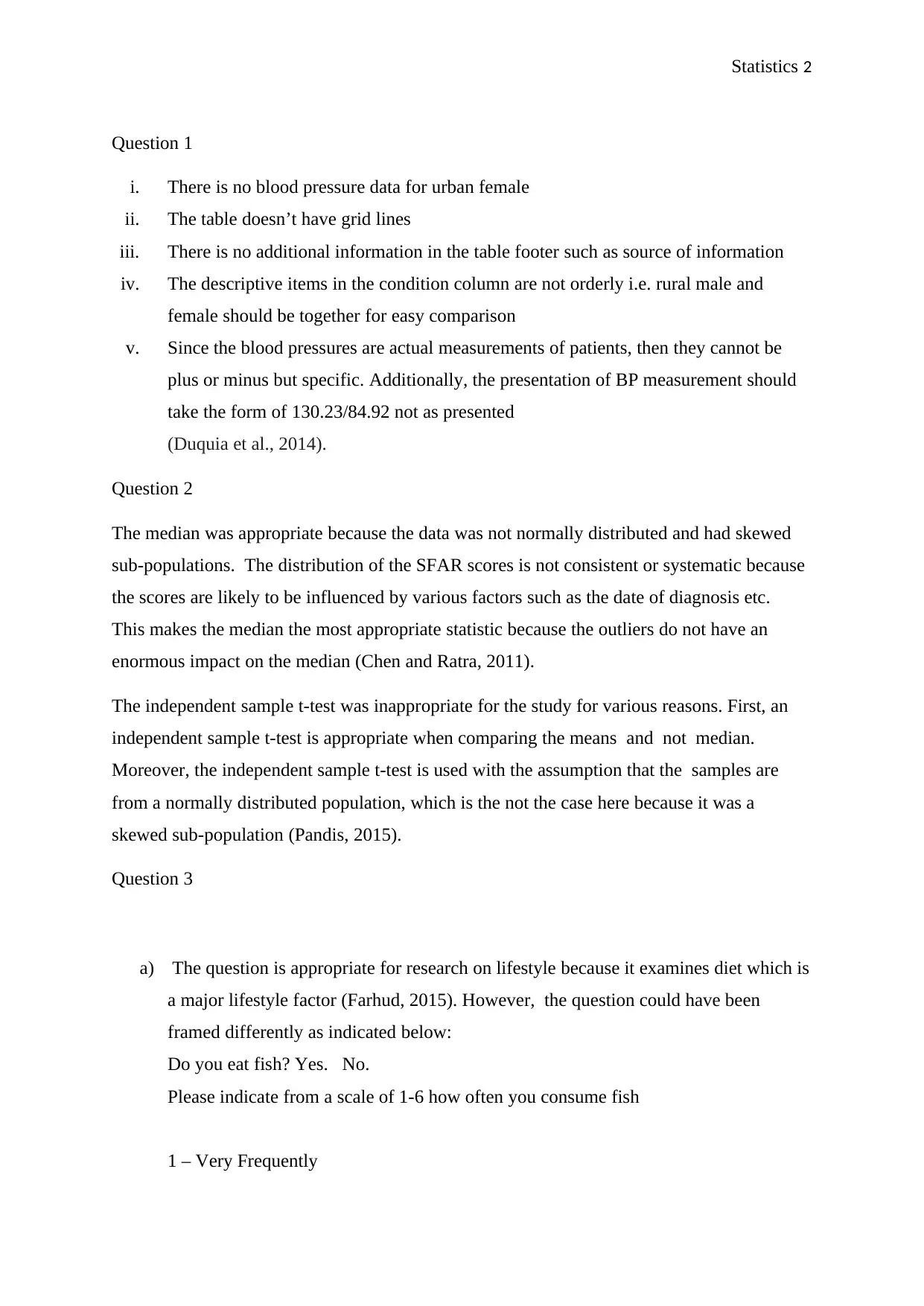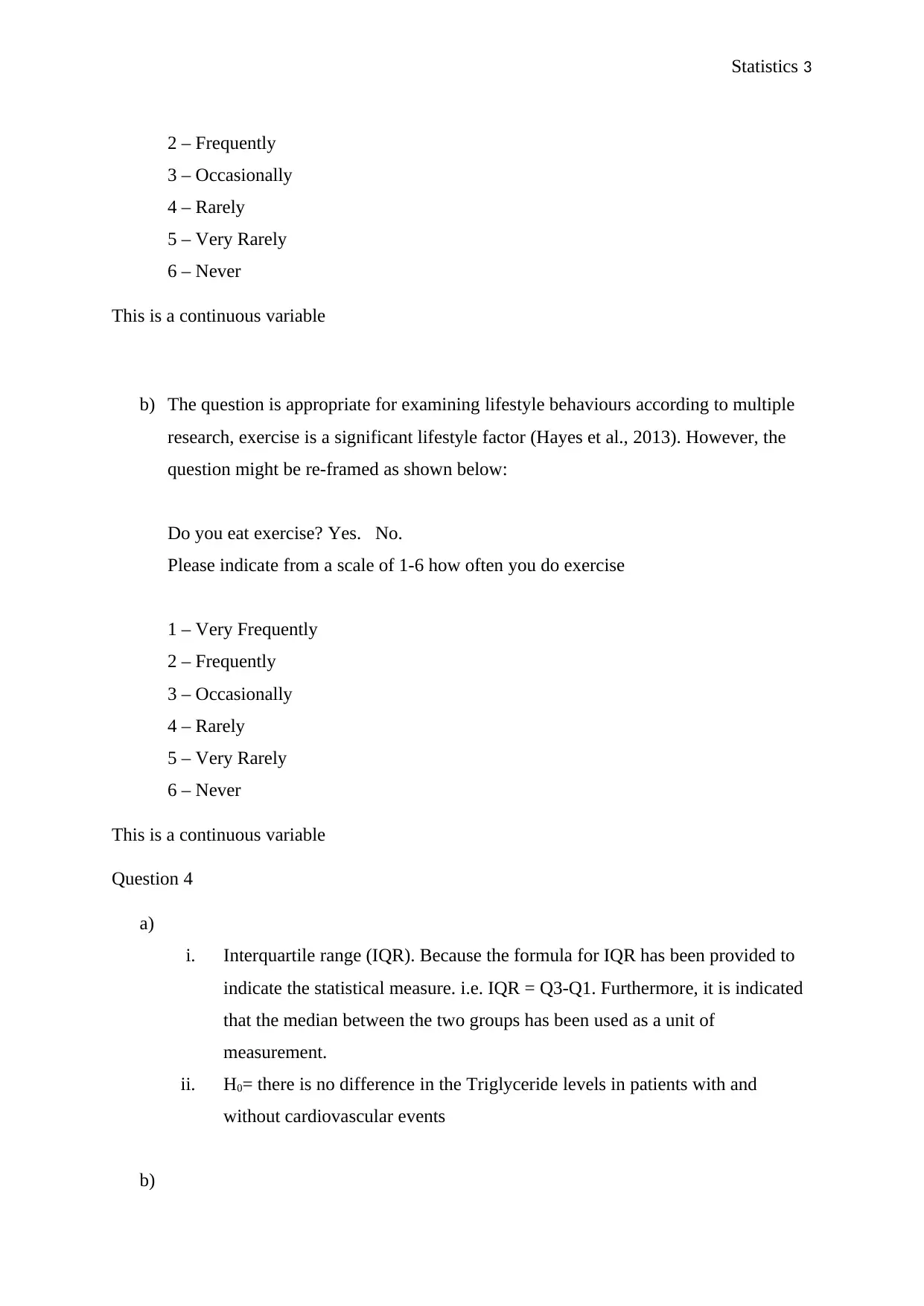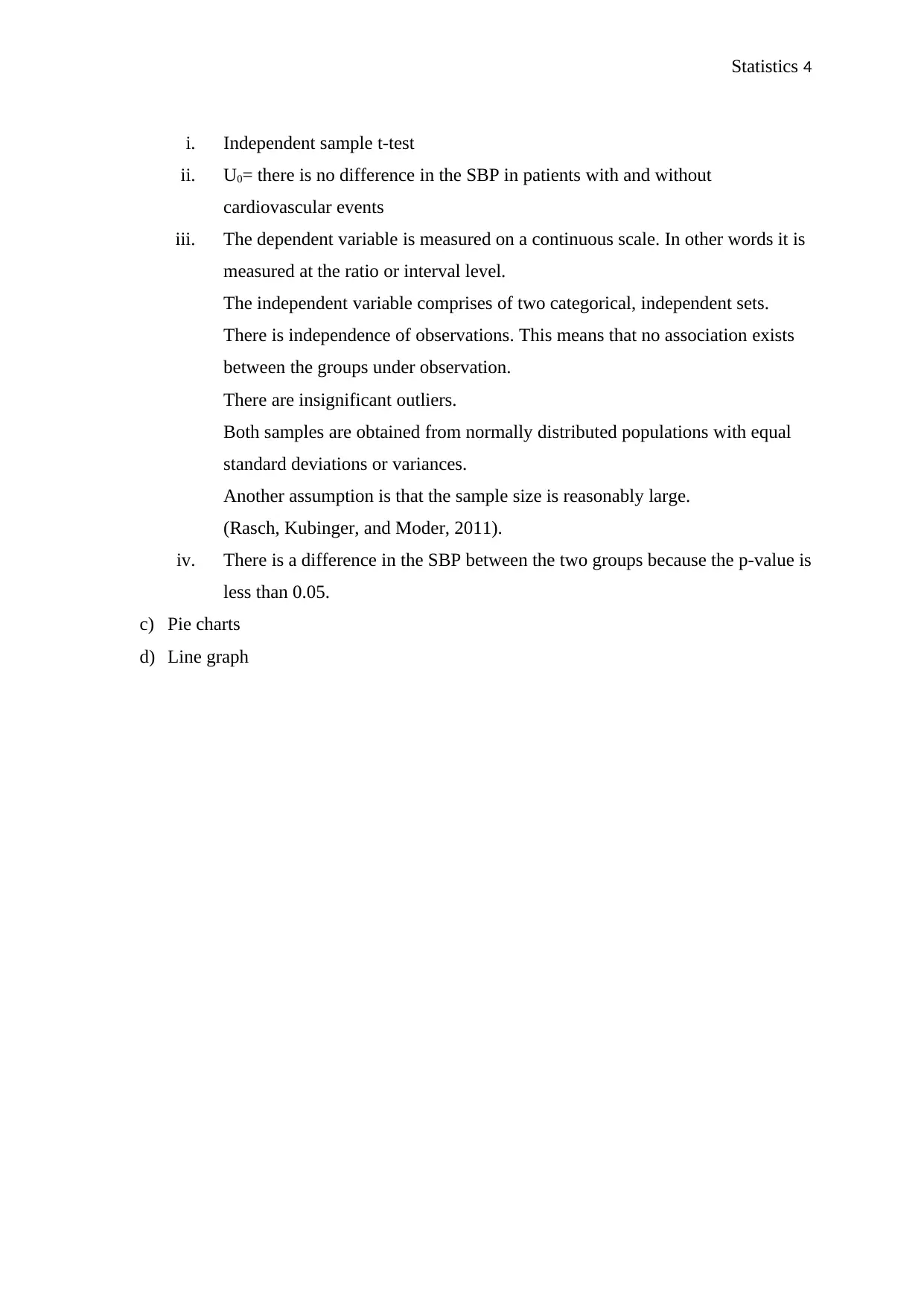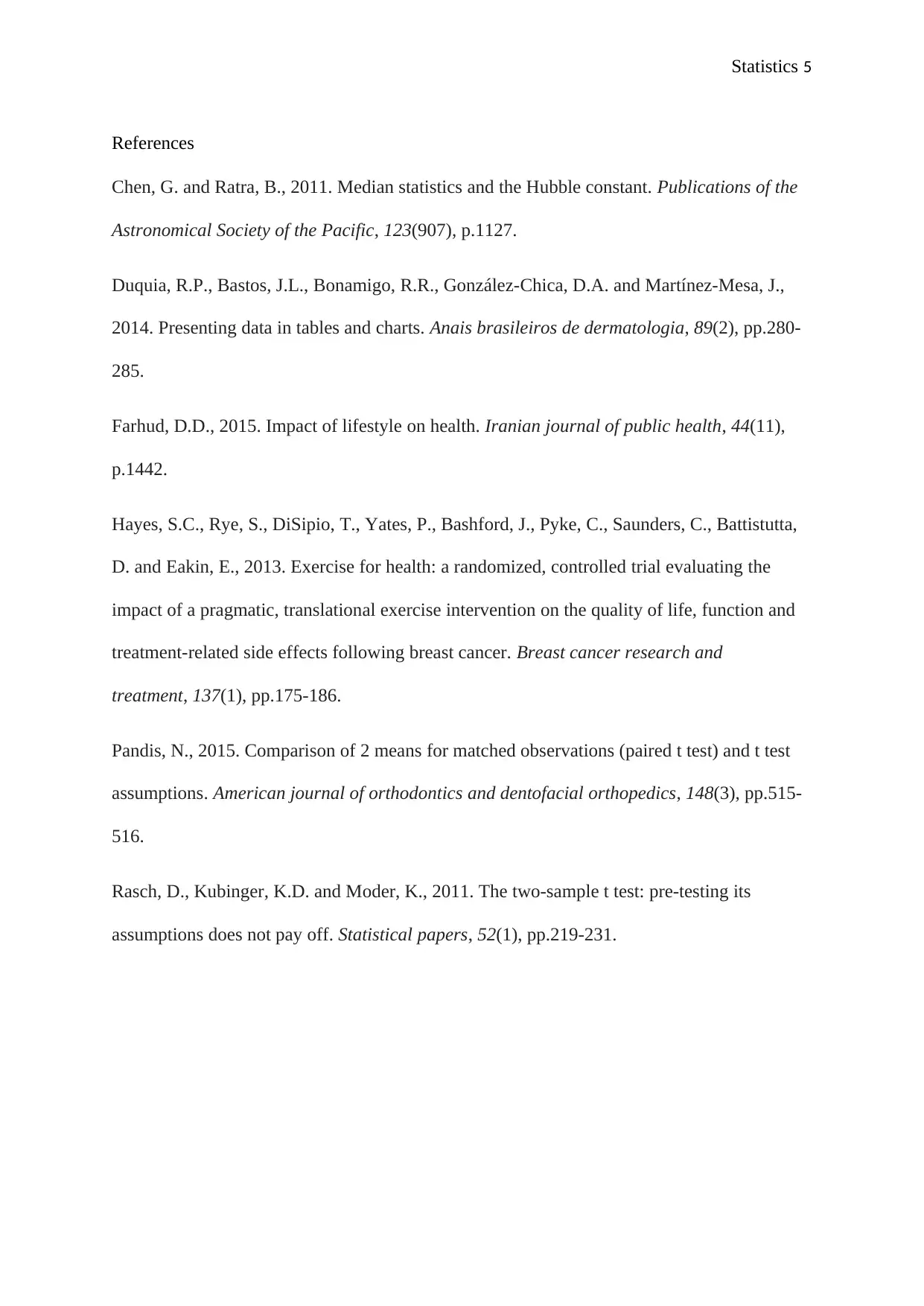Statistics Homework: Critical Appraisal of Published Research Data
VerifiedAdded on 2023/04/19
|5
|930
|269
Homework Assignment
AI Summary
This assignment provides a detailed critical appraisal of statistical results from published literature. It identifies errors in data presentation, evaluates the appropriateness of statistical tests like the independent sample t-test and median, and suggests improvements to survey questions related to lifestyle factors such as diet and exercise. The solution includes explanations of statistical measures like interquartile range (IQR) and hypothesis testing, along with appropriate graphical representations like pie charts and line graphs. The document is available on Desklib, a platform offering a wide range of study resources including past papers and solved assignments for students.

Statistics 1
Statistics
By:
Student ID:
Course No:
Tutor:
Date:
Statistics
By:
Student ID:
Course No:
Tutor:
Date:
Paraphrase This Document
Need a fresh take? Get an instant paraphrase of this document with our AI Paraphraser

Statistics 2
Question 1
i. There is no blood pressure data for urban female
ii. The table doesn’t have grid lines
iii. There is no additional information in the table footer such as source of information
iv. The descriptive items in the condition column are not orderly i.e. rural male and
female should be together for easy comparison
v. Since the blood pressures are actual measurements of patients, then they cannot be
plus or minus but specific. Additionally, the presentation of BP measurement should
take the form of 130.23/84.92 not as presented
(Duquia et al., 2014).
Question 2
The median was appropriate because the data was not normally distributed and had skewed
sub-populations. The distribution of the SFAR scores is not consistent or systematic because
the scores are likely to be influenced by various factors such as the date of diagnosis etc.
This makes the median the most appropriate statistic because the outliers do not have an
enormous impact on the median (Chen and Ratra, 2011).
The independent sample t-test was inappropriate for the study for various reasons. First, an
independent sample t-test is appropriate when comparing the means and not median.
Moreover, the independent sample t-test is used with the assumption that the samples are
from a normally distributed population, which is the not the case here because it was a
skewed sub-population (Pandis, 2015).
Question 3
a) The question is appropriate for research on lifestyle because it examines diet which is
a major lifestyle factor (Farhud, 2015). However, the question could have been
framed differently as indicated below:
Do you eat fish? Yes. No.
Please indicate from a scale of 1-6 how often you consume fish
1 – Very Frequently
Question 1
i. There is no blood pressure data for urban female
ii. The table doesn’t have grid lines
iii. There is no additional information in the table footer such as source of information
iv. The descriptive items in the condition column are not orderly i.e. rural male and
female should be together for easy comparison
v. Since the blood pressures are actual measurements of patients, then they cannot be
plus or minus but specific. Additionally, the presentation of BP measurement should
take the form of 130.23/84.92 not as presented
(Duquia et al., 2014).
Question 2
The median was appropriate because the data was not normally distributed and had skewed
sub-populations. The distribution of the SFAR scores is not consistent or systematic because
the scores are likely to be influenced by various factors such as the date of diagnosis etc.
This makes the median the most appropriate statistic because the outliers do not have an
enormous impact on the median (Chen and Ratra, 2011).
The independent sample t-test was inappropriate for the study for various reasons. First, an
independent sample t-test is appropriate when comparing the means and not median.
Moreover, the independent sample t-test is used with the assumption that the samples are
from a normally distributed population, which is the not the case here because it was a
skewed sub-population (Pandis, 2015).
Question 3
a) The question is appropriate for research on lifestyle because it examines diet which is
a major lifestyle factor (Farhud, 2015). However, the question could have been
framed differently as indicated below:
Do you eat fish? Yes. No.
Please indicate from a scale of 1-6 how often you consume fish
1 – Very Frequently

Statistics 3
2 – Frequently
3 – Occasionally
4 – Rarely
5 – Very Rarely
6 – Never
This is a continuous variable
b) The question is appropriate for examining lifestyle behaviours according to multiple
research, exercise is a significant lifestyle factor (Hayes et al., 2013). However, the
question might be re-framed as shown below:
Do you eat exercise? Yes. No.
Please indicate from a scale of 1-6 how often you do exercise
1 – Very Frequently
2 – Frequently
3 – Occasionally
4 – Rarely
5 – Very Rarely
6 – Never
This is a continuous variable
Question 4
a)
i. Interquartile range (IQR). Because the formula for IQR has been provided to
indicate the statistical measure. i.e. IQR = Q3-Q1. Furthermore, it is indicated
that the median between the two groups has been used as a unit of
measurement.
ii. H0= there is no difference in the Triglyceride levels in patients with and
without cardiovascular events
b)
2 – Frequently
3 – Occasionally
4 – Rarely
5 – Very Rarely
6 – Never
This is a continuous variable
b) The question is appropriate for examining lifestyle behaviours according to multiple
research, exercise is a significant lifestyle factor (Hayes et al., 2013). However, the
question might be re-framed as shown below:
Do you eat exercise? Yes. No.
Please indicate from a scale of 1-6 how often you do exercise
1 – Very Frequently
2 – Frequently
3 – Occasionally
4 – Rarely
5 – Very Rarely
6 – Never
This is a continuous variable
Question 4
a)
i. Interquartile range (IQR). Because the formula for IQR has been provided to
indicate the statistical measure. i.e. IQR = Q3-Q1. Furthermore, it is indicated
that the median between the two groups has been used as a unit of
measurement.
ii. H0= there is no difference in the Triglyceride levels in patients with and
without cardiovascular events
b)
⊘ This is a preview!⊘
Do you want full access?
Subscribe today to unlock all pages.

Trusted by 1+ million students worldwide

Statistics 4
i. Independent sample t-test
ii. U0= there is no difference in the SBP in patients with and without
cardiovascular events
iii. The dependent variable is measured on a continuous scale. In other words it is
measured at the ratio or interval level.
The independent variable comprises of two categorical, independent sets.
There is independence of observations. This means that no association exists
between the groups under observation.
There are insignificant outliers.
Both samples are obtained from normally distributed populations with equal
standard deviations or variances.
Another assumption is that the sample size is reasonably large.
(Rasch, Kubinger, and Moder, 2011).
iv. There is a difference in the SBP between the two groups because the p-value is
less than 0.05.
c) Pie charts
d) Line graph
i. Independent sample t-test
ii. U0= there is no difference in the SBP in patients with and without
cardiovascular events
iii. The dependent variable is measured on a continuous scale. In other words it is
measured at the ratio or interval level.
The independent variable comprises of two categorical, independent sets.
There is independence of observations. This means that no association exists
between the groups under observation.
There are insignificant outliers.
Both samples are obtained from normally distributed populations with equal
standard deviations or variances.
Another assumption is that the sample size is reasonably large.
(Rasch, Kubinger, and Moder, 2011).
iv. There is a difference in the SBP between the two groups because the p-value is
less than 0.05.
c) Pie charts
d) Line graph
Paraphrase This Document
Need a fresh take? Get an instant paraphrase of this document with our AI Paraphraser

Statistics 5
References
Chen, G. and Ratra, B., 2011. Median statistics and the Hubble constant. Publications of the
Astronomical Society of the Pacific, 123(907), p.1127.
Duquia, R.P., Bastos, J.L., Bonamigo, R.R., González-Chica, D.A. and Martínez-Mesa, J.,
2014. Presenting data in tables and charts. Anais brasileiros de dermatologia, 89(2), pp.280-
285.
Farhud, D.D., 2015. Impact of lifestyle on health. Iranian journal of public health, 44(11),
p.1442.
Hayes, S.C., Rye, S., DiSipio, T., Yates, P., Bashford, J., Pyke, C., Saunders, C., Battistutta,
D. and Eakin, E., 2013. Exercise for health: a randomized, controlled trial evaluating the
impact of a pragmatic, translational exercise intervention on the quality of life, function and
treatment-related side effects following breast cancer. Breast cancer research and
treatment, 137(1), pp.175-186.
Pandis, N., 2015. Comparison of 2 means for matched observations (paired t test) and t test
assumptions. American journal of orthodontics and dentofacial orthopedics, 148(3), pp.515-
516.
Rasch, D., Kubinger, K.D. and Moder, K., 2011. The two-sample t test: pre-testing its
assumptions does not pay off. Statistical papers, 52(1), pp.219-231.
References
Chen, G. and Ratra, B., 2011. Median statistics and the Hubble constant. Publications of the
Astronomical Society of the Pacific, 123(907), p.1127.
Duquia, R.P., Bastos, J.L., Bonamigo, R.R., González-Chica, D.A. and Martínez-Mesa, J.,
2014. Presenting data in tables and charts. Anais brasileiros de dermatologia, 89(2), pp.280-
285.
Farhud, D.D., 2015. Impact of lifestyle on health. Iranian journal of public health, 44(11),
p.1442.
Hayes, S.C., Rye, S., DiSipio, T., Yates, P., Bashford, J., Pyke, C., Saunders, C., Battistutta,
D. and Eakin, E., 2013. Exercise for health: a randomized, controlled trial evaluating the
impact of a pragmatic, translational exercise intervention on the quality of life, function and
treatment-related side effects following breast cancer. Breast cancer research and
treatment, 137(1), pp.175-186.
Pandis, N., 2015. Comparison of 2 means for matched observations (paired t test) and t test
assumptions. American journal of orthodontics and dentofacial orthopedics, 148(3), pp.515-
516.
Rasch, D., Kubinger, K.D. and Moder, K., 2011. The two-sample t test: pre-testing its
assumptions does not pay off. Statistical papers, 52(1), pp.219-231.
1 out of 5
Related Documents
Your All-in-One AI-Powered Toolkit for Academic Success.
+13062052269
info@desklib.com
Available 24*7 on WhatsApp / Email
![[object Object]](/_next/static/media/star-bottom.7253800d.svg)
Unlock your academic potential
Copyright © 2020–2025 A2Z Services. All Rights Reserved. Developed and managed by ZUCOL.




